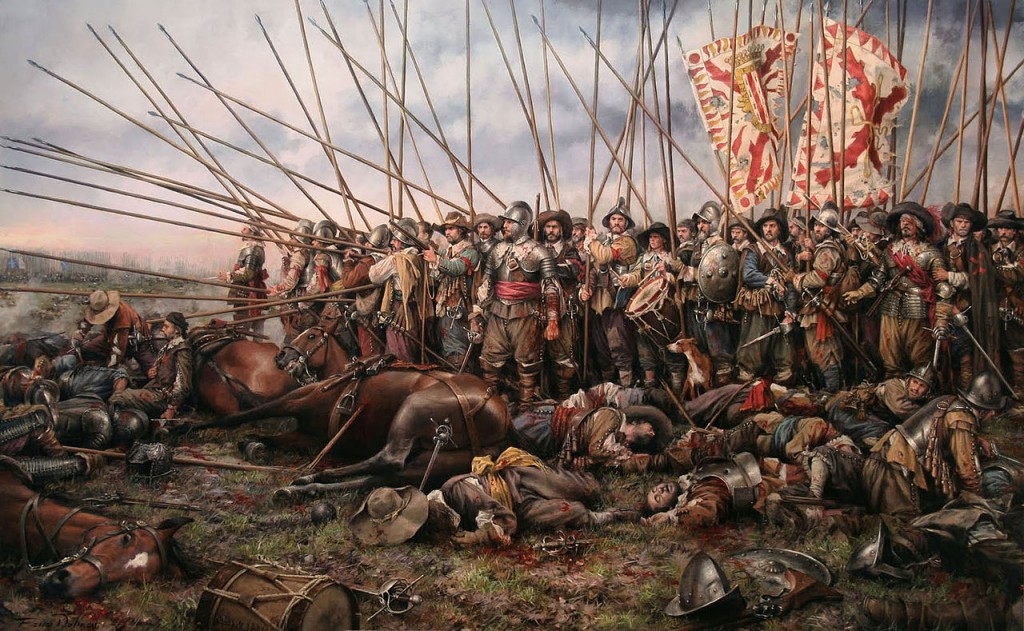If simplicity in game design is beautiful, SPI’s Musket & Pike is a real jewel.
Musket & Pike covers a unique period in the history of warfare that was post-medieval but not yet modern. Before this time, gunpowder weapons were almost unheard of, novelty at best, while after this period, it was unthinkable that troops without guns could stand against trained forces that did possess them. Musket & Pike does a decent job of creating a mechanically balanced system for battles featuring mixed forces that is simple to play and can cover any number of battles over a roughly hundred year period with a single set of counters.
Using a large low-detail map with a handful of key strategic features and two nearly mirrored sets of various generic units*, Musket & Pike recreates nearly twenty battles from the late 16th to 17th century (with a heavy focus on the 30 Years War) while giving players enough of a tool box to create many more of their own.

Units consist of pikemen, gunners, cavalry or cannons and vary in quality by training in the case of the first two and by light vs heavy in the case of the latter two. Gameplay moves in a fairly smooth shoot-move-melee sequence. Gun/cannon attack values are figured out by the troop/cannon quality and range-based strength modification by type; the sum of attackers’ strength is used to figure the odds against a hex’s fixed terrain-based defense value. Boom! Troops scatter before the musket fire! Then a player uses his pikemen and cavalry to make attacks and run down stragglers, figuring odds based on troop strength.
The first scenario we’ve had a chance to play is the Battle of White Mountain. The Holy Roman Empire has to annihilate the Bohemians for a win. The generic nature of the map is somewhat limiting in terms of accurate representation of the fields, so purists might be disappointed, but what Musket & Pike gives us is an attack coming from a town against an outnumbered force that has higher ground. The way the scenario has played out has been interesting for a handful of reasons. As the game lacks zones of control, maneuvers to trap forces can result in break-outs in the strangest places. By the end of the second turn, the battlefield was a chaotic mess. Since the cavalry had moved around my flanks to the rear, my best option became to shoot my way through the middle. The well-formed setup lines of pikemen and musketeers were quickly dispersed in all direction.
Musket & Pike is a great beginner’s game. The back and forth is fun and the pacing is quick. I’ve even got an eye on trying out the rules with miniatures. While this doesn’t have a lot of gristle for historical war gamers who want highly accurate simulations of this or that battle, the flexibility put forward by Musket & Pike offers a lot of replayability, whether through the included scenarios, homebrews or rules variants. There’s a lot of value in this one.
*: Green and Blue counter sets do have differences, but there are scenarios where both sides could be adequately soldiered by either color.
-Alex
Love this game, as well as all as the similar pre-PRESTAGs games, such as Phalanx. Simple to play but I think they all give a good feel for tactical combat in the relevant era. I consider the generic map more a feature than a bug, as it is an elegant way to be able to play multiple scenarios covering a long period of time cheaply.
I really wish this was still in print. I like the period and I like games with low complexity. I grew up playing Tactics II with my old man and besides my dad’s obsession with tactical nukes we barely tweaked it at all.
If I didn’t have too much going on I would do that. But I still need to make counters for Ogre Suit Gundam. Too many interests, not enough time!
I will have to add that to the queue though, too good not to pass up.